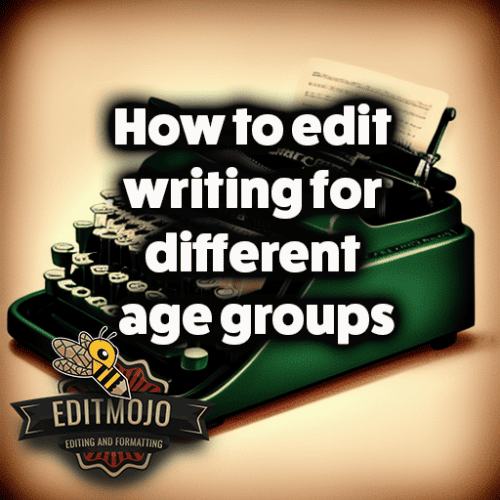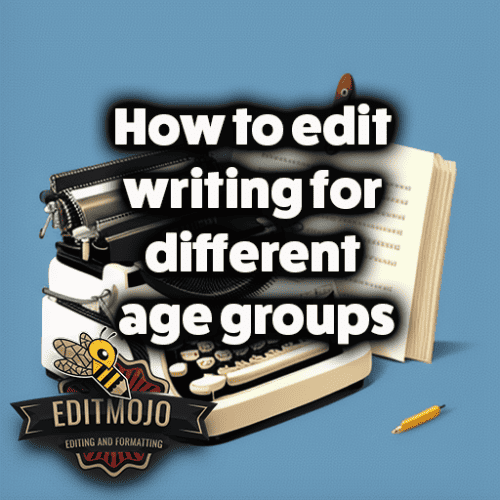How to edit writing for different age groups
How to edit writing for different age groups. In the heart of every successful literary masterpiece lies the art and skill of meticulous editing. Editing goes beyond correcting spelling errors and misplaced punctuation. It involves refining the essence of a piece of writing, ensuring that it resonates with its intended audience. When it comes to audience, age is a significant factor that shapes their reading preferences and comprehension levels. This post is a comprehensive guide on how to edit writing for different age groups. Buckle up for a literary adventure that spans from early childhood tales to engrossing adult novels.
Key Takeaways
| Aspect | Key Takeaways |
|---|---|
| Early Childhood | Use simple language, repetitions, moral lessons, and illustrative components. |
| Middle Grade | Introduce complex themes, humor, adventure, and relatable characters. |
| Young Adults | Tackle real-life issues, emotional themes, and incorporate popular genres like fantasy, romance, and mystery. |
| Adults | Employ nuanced language, intricate narratives, and diverse genres and themes. |
| Editing Principles | Match language, content structure, and themes to the reader’s age and maturity. |
| Editing Process | Assess draft, revise language, refine content structure, check for readability and engagement, gather feedback, and perform final revisions. |
| Common Mistakes | Avoid oversimplification or overcomplication of language, inappropriate themes, and ignoring age-specific interests. |
Understanding Age Groups and Their Literary Needs
Early Childhood (ages 3-8)
Young children are like sponges ready to absorb knowledge in the most engaging and appealing ways. Their literary world is dominated by simple language, vibrant illustrations, rhythmic rhymes, and a sprinkle of magic. A study by Language Learning suggests that repetition plays a critical role in language acquisition in early childhood. Besides, stories for this age group often contain valuable learning lessons, portraying moral values through lovable characters and captivating adventures.
Middle Grade (ages 8-12)
At this age, children have mastered the basics of language and are ready to explore more complex themes, albeit still within a safe and imaginative space. They appreciate humor and adventure, and their heroes and heroines are often relatable characters tackling real-life challenges. As acclaimed author Rick Riordan suggests, these readers “want stories that allow them to stretch their wings”.

Young Adults (ages 12-18)
Young adults are in a transitional phase, seeking to make sense of the world and their place in it. Thus, their literature often mirrors these explorations. Real-life issues, emotional roller-coasters, friendships, first loves, and identity struggles are typical themes. Yet, the realm of fantasy, mystery, and dystopia also holds considerable allure for this age group, offering an escape from their own trials.
Adults (18+)
Adult readers, with their sophisticated comprehension skills, enjoy an expansive array of themes, characters, and plot complexities. They relish nuanced language and layered narratives, with no genre off-limits. As Stephen King once noted, “Books are a uniquely portable magic.”
Fundamental Principles of Editing for Different Age Groups
- Matching Language, Syntax, and Vocabulary to Age Group: From ‘babyish’ talk to profound philosophical musings, language must be tailored to fit the readers.
- Tailoring Content Structure and Complexity According to the Reader’s Maturity: The plot and themes should engage the reader’s cognitive and emotional development level.
- Ensuring the Relevance and Appropriate Themes for the Target Age Group: Content should resonate with the reader’s experiences, aspirations, fears, and joys.
Step-by-Step Guide on How to Edit Writing for Different Age Groups
Step 1: Assess the Initial Draft
Recognizing the author’s intent and identifying the potential readership’s age group is the first crucial step. This initial assessment guides the entire editing process, ensuring that the text maintains its core value while enhancing its appeal for the target readers.

Step 2: Revising Language and Vocabulary
This step involves substituting complex words with simpler ones for younger readers, ensuring syntactic simplicity, and inserting age-appropriate
slang or jargon. For adult writing, you might focus on enriching the text with sophisticated language, diverse vocabulary, and rhetorical devices.
Step 3: Refining Content Structure and Themes
A skilled editor refines the storyline, plot structure, and themes to ensure consistency and relevance. For example, a story for middle graders might involve a quest or a journey with a clear moral lesson, while a novel for young adults might delve deeper into interpersonal relationships, identity exploration, and moral ambiguities.
Step 4: Checking for Age-Appropriate Readability and Engagement
Younger children might require more illustrations or visual aids to maintain engagement. For older readers, coherence, logical flow, and well-crafted suspense are crucial for maintaining their interest.
Step 5: Feedback and Further Revisions
Beta readers from the target age group can provide invaluable insights, and their feedback should be integrated into the final revisions.

Common Mistakes to Avoid When Editing for Different Age Groups
An essential part of the process is knowing what pitfalls to avoid. Overcomplicating or oversimplifying language can deter the reader, and the introduction of inappropriate themes can lead to backlash. Most importantly, neglecting age-specific interests and concerns can result in a piece that falls flat, failing to engage its intended audience.
Case Studies: Successful Editing Examples for Different Age Groups
Consider J.K. Rowling’s Harry Potter series, which transitions from middle-grade to young adult fiction. The series grows with its readers, reflecting their evolving emotional and cognitive maturity.
On the other hand, George R.R. Martin’s ‘A Song of Ice and Fire’ series offers a compelling case study for adult readers. With its complex narrative structure, intricate plotlines, and mature themes, it provides an immersive experience for adult readers.
Conclusion
Editing writing for different age groups requires a keen understanding of each age group’s unique needs, interests, and comprehension abilities. It’s not merely about simplifying or complicating the language and structure but, more importantly, about creating a piece that speaks to the readers’ hearts and minds.
In the end, well-edited content makes for more engaging and enjoyable reading experiences, connecting readers of all ages to the magic of literature. As Ernest Hemingway once said, “There is no friend as loyal as a book.”
Additional Resources
For those interested in exploring further, here are some resources:
- The Artful Edit, a book by Susan Bell, offers insights into the art of editing.
- Grammarly and Hemingway Editor, online editing tools, can aid in checking readability and grammar.
- The OpenAI Blog, provides insights into language acquisition and processing, adding another layer to your understanding of age-specific language preferences.
Top Five Questions and Answers
- Q: Why is it important to edit writing according to different age groups? A: Different age groups have varying comprehension abilities, interests, and experiences. Editing content to match these factors ensures that the material is engaging, understandable, and relevant to the readers.
- Q: How can I make sure that my writing is appropriate for young children? A: Keep your language simple and clear, use lots of repetition, incorporate moral lessons, and consider including illustrations to engage young readers.
- Q: What type of content appeals to young adult readers? A: Young adults often gravitate towards content that explores real-life issues, emotions, identity struggles, and relationships. They also enjoy genres like fantasy, mystery, and dystopia.
- Q: What are some common mistakes to avoid when editing for different age groups? A: Some common mistakes include oversimplifying or overcomplicating language, introducing inappropriate themes, and ignoring the interests and concerns specific to the age group.
- Q: How can I gather feedback on my writing for different age groups? A: Engage beta readers from your target age group. Their feedback can provide invaluable insights into how well your content resonates with the intended audience.
